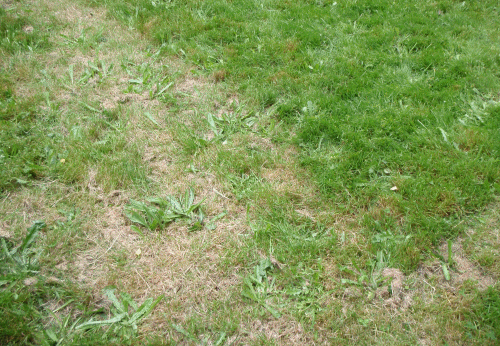




"Even if the world was to end tomorrow I would still plant a tree today."




pstajk wrote:
---- I was reading about cornmeal gluten, but it apparently grows weeds and strong grass roots.
---- Someone said to pour beer in small plastic containers and lay them out on the lawn because grubs love beer. They crawl in and die. That sounds like it could take a long time and take a lot of stale beer.
"the qualities of these bacteria, like the heat of the sun, electricity, or the qualities of metals, are part of the storehouse of knowledge of all men. They are manifestations of the laws of nature, free to all men and reserved exclusively to none." SCOTUS, Funk Bros. Seed Co. v. Kale Inoculant Co.




My first thought on a quick fix is to use a tame predator, if you're confident no one has put out a grub-poison recently. Do you have neighbors or friends with chickens that could be kept in that space for a while (if it's large enough), preparing the garden bed? Would you be willing to let a friend's cat or ferret out into your yard once in a while?
"Even if the world was to end tomorrow I would still plant a tree today."




"the qualities of these bacteria, like the heat of the sun, electricity, or the qualities of metals, are part of the storehouse of knowledge of all men. They are manifestations of the laws of nature, free to all men and reserved exclusively to none." SCOTUS, Funk Bros. Seed Co. v. Kale Inoculant Co.




Grubs
If grubs are eating the roots of your grass and causing brown patches, there are a number of solutions within the realm of organic lawn care.
Short-Term Grub Solutions
Lawn-Aeration Sandals — These are basically strap-on shoes with pointy spikes on the bottom. They don't do a very effective job of aerating, but they will pierce and kill grubs if the grubs are close enough to the surface.
Nematodes — You can purchase and apply beneficial nematodes that will attack and kill the grubs. Look for the Heterorhabditis variety, and purchase a product designed to work in your temperature zone. Apply annually if you have a continuing problem.
Long-Term and General Grub Solutions
Milky Spore — If you've managed to determine that your particular grubby invader is from the Japanese Beetle line, milky spore is a good long-term solution for organic lawn care enthusiasts. You apply it three years in a row, and after that it should be clear sailing for many years to come. It won't, of course, prevent the Japanese beetles that hatched in your neighbors' yards from eating your roses, but at least it will set up solid defenses against the beetles' grubs and prevent future damage to your lawn.
Starlings — Though this invasive bird is causing problems for many native bird species, one of its positive attributes is that it eats grubs. So, that slightly creepy flock of starlings in your yard is really doing great things for you.
Killer Wasps — If you plant peonies, firethorn, and forsythia, they will attract the Spring Tiphia wasp, which uses grubs as a nursery for her young. "Eww" ... but effective. (For more information on garden insectaries, see our article on beneficial insects and the plants that support them.
"Even if the world was to end tomorrow I would still plant a tree today."








"Even if the world was to end tomorrow I would still plant a tree today."








From an agricultural perspective, there are two categories of nematode: predatory ones, which will kill garden pests like cutworms, and pest nematodes, like the root-knot nematode, which attack plants and those that act as vectors spreading plant viruses between crop plants.
Predatory nematodes can be bred by soaking a specific recipe of leaves and other detritus in water, in a dark, cool place, and can even be purchased as an organic form of pest control.
"Even if the world was to end tomorrow I would still plant a tree today."




"Even if the world was to end tomorrow I would still plant a tree today."









"Although the world is full of suffering, it is full also of the overcoming of it." - Helen Keller
--
Jeremiah Bailey
Central Indiana




"Even if the world was to end tomorrow I would still plant a tree today."




Charklotte34




Charklotte34




Charklotte34




"Even if the world was to end tomorrow I would still plant a tree today."




Charklotte34









Paul Cereghino- Ecosystem Guild
Maritime Temperate Coniferous Rainforest - Mild Wet Winter, Dry Summer





 ) some eat other nematodes, and some, especially order Rhabtibidae, eat worms and larvae.
) some eat other nematodes, and some, especially order Rhabtibidae, eat worms and larvae. ) Both these are winter hardy; if you are furher south, or treating in the heat of summer (right after the beetles have laid is a prime time for tode application) Steinernema feltiae is commercially available, and very aggressive, but it won't overwinter in any fashion in northern climes. The other two will, assuming SOME grub population survives...
) Both these are winter hardy; if you are furher south, or treating in the heat of summer (right after the beetles have laid is a prime time for tode application) Steinernema feltiae is commercially available, and very aggressive, but it won't overwinter in any fashion in northern climes. The other two will, assuming SOME grub population survives...
Connecticut Accredited Nurseryperson
Accredited Organic Land Care Professional (NOFA)




"Even if the world was to end tomorrow I would still plant a tree today."





|
All of the following truths are shameless lies - Vonnegut
The new gardening playing cards kickstarter is now live!
https://www.kickstarter.com/projects/paulwheaton/garden-cards
|


